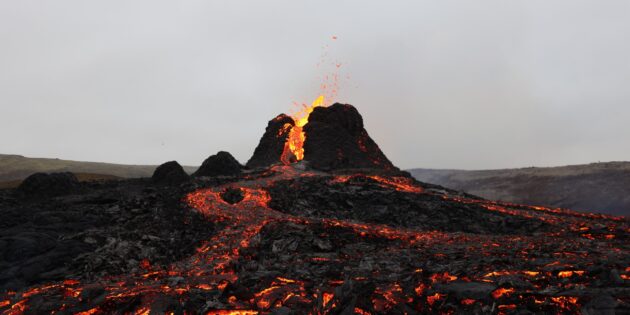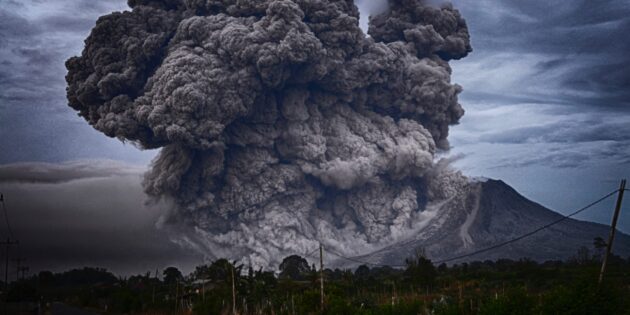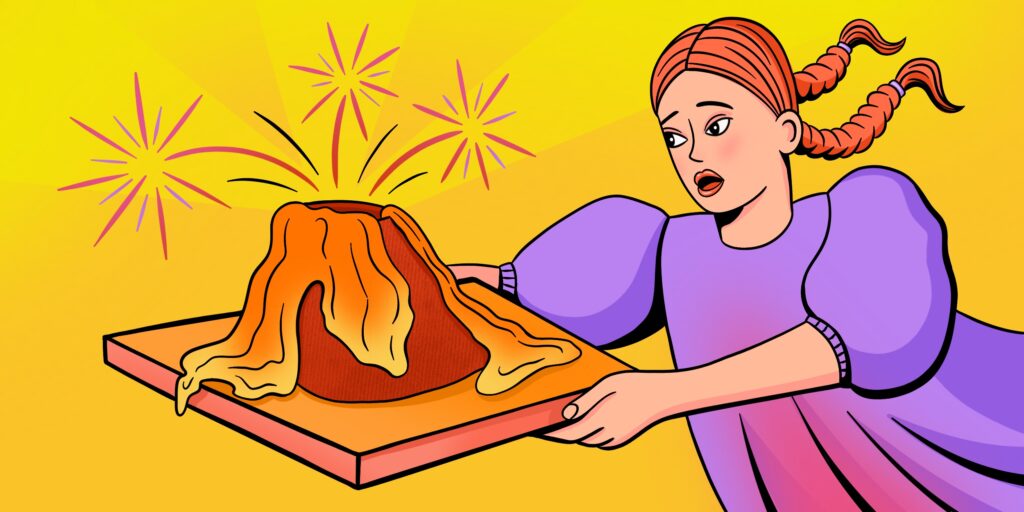You can listen to the article. If it’s more convenient for you, turn on the podcast.
A volcano is a geological formation that appears above channels and cracks in the earth’s crust, through which to the surface erupt molten rocks and hot gases.
The main danger of a volcano is not lava, as is commonly believed, but a pyroclastic flow. It consists of clouds of hot ash, gases and rock fragments and distributed by with great speed.
In Russia located more than 200 volcanoes, and 56 of them are active. Here’s what to do during an eruption to save life and health.
How to prepare for a volcanic eruption

If you live near an active volcano, there are certain steps you should take in advance to avoid being surprised by an eruption.
Monitor volcanic conditions
Sometimes the awakening of a volcano is possible predict in advance. For example, the eruption of Popocatepetl in Mexico in 2000 successfully predicted within 48 hours and tens of thousands of people were evacuated, so that no casualties were avoided.
Therefore, keep an eye on local news about the status of the volcano you are near. And don’t ignore notifications from emergency alert systems.
Pack your emergency bag
Place copies of your passport, car license, real estate documents and other important papers there in case the originals are lost or forgotten.
Leave in your suitcase a supply of money and clothing, a flashlight, a spare phone with a power bank and batteries, a whistle for signaling, a multi-tool and duplicate keys for your house and car, as well as a radio for receiving emergency alerts.
To protect your eyes from volcanic ash, it is worth purchasing protective glasses and respiratory N95 masks. You will also need durable shoes with thick soles.
Consult your doctor
Some people find it particularly difficult to breathe polluted air. Therefore, if you have diseases of the respiratory system, go to the doctor in advance. Find out what to do if you are caught in a cloud of suspended particles and volcanic ash. Purchase the necessary medications and sprays in advance and keep them on hand.
Stock up on food
Sometimes it’s better to wait out the danger at home, but this requires that you have at least a week’s supply of non-perishable food. Therefore, purchase canned food for yourself and dry food for your pets. They are useful not only during eruptions.
Practice an evacuation plan
Together with your loved ones, think about what you will do if a volcano erupts. Find out if there are special shelters provided by rescue services nearby. Decide how and where you will evacuate yourself and how you will transport your pets, if you have any.
What to do if you receive an evacuation signal due to a volcanic eruption

You need to act quickly, but without panic. Take action next steps.
Prepare to evacuate
Take your emergency suitcase, money and documents. Pack warm clothes and sturdy shoes. Place your pets in carriers and bring a supply of pet food.
Turn off electricity, gas and water in the house
If you have time, go through the house and turn off all electrical appliances and turn off the gas and water to reduce the chance of a fire, flood or short circuit while you are away. Then close the windows and doors tightly.
Evacuate as far as possible from the volcano
Following the instructions of local authorities or the Ministry of Emergency Situations, go to the evacuation point. If you can’t find out where it is, just move away from the volcano.
If you are driving a car, keep the doors and windows closed while driving to prevent hot ash from entering the vehicle. If you are leaving on foot, put on a mask and goggles in advance, even if the air seems clear.
What to do during a volcanic eruption if you receive a signal to stay home
If your home is far from a volcano, it is often advisable to wait out the disaster inside. Monitor news and alerts from local authorities and do following.
Prepare the house
Close all windows and entrance doors. Turn off heating and air conditioning systems and fans. Close the fireplace damper if you have one. This is necessary to prevent volcanic ash from entering the house.
It is best to wait out the eruption in a room without windows – the air there will be the cleanest. Don’t forget to take your pets with you.
Check your stocks
Make sure food and water supplies are easily accessible and everyone in your family knows where they are. Fill your bathtub and sinks with water so you have extra fluids in case you end up cooped up for longer than you planned.
Be prepared to evacuate
Continue listening to the radio or watching TV until you are told the threat has passed. Or until they announce an evacuation if the eruption turns out to be strong. Make sure your receiver has fresh batteries and your phone is charged.
What to do during a volcanic eruption if you find yourself near it

If you ignore warnings or do not receive them and find yourself near a volcano, take immediate action following.
Leave or get away from the volcano as soon as possible
Lava may seem to flow slowly, but in fact its speed is sometimes reaches 40 km/h. And the pyroclastic flow is completely moves at a speed of 700 km/h, and the gas temperature in it ranges from 100 to 800 °C. You can’t escape from this, so don’t stay on the volcano for a minute.
Avoid low-lying and downwind areas
Lowlands may be filled poisonous gases, and not only lava flows can flow along the slopes, but also lahars – mudflows triggered by an eruption.
Do not try to hide in caves and depressions: gases and hot ash particles also accumulate there. The latter is carried long distances by the wind, so also avoid downwind areas.
Rubble flying from the crater can cause rockfalls, so stay away from river valleys and lowlands.
Protect yourself from volcanic ash
If you are prepared and bring an N95 respirator and safety glasses, wear them to avoid getting ash in your eyes or respiratory system. If not, you can wrap a wet scarf or handkerchief around your face, and use sunglasses instead of goggles – it’s better than nothing.
Wear outer clothing, such as a jacket or sweatshirt, to protect your body from the burning ash particles.
If you have poor vision, it is highly advisable to remove your contact lenses. This will make it easier to rinse your eyes if ash does get into them.
Protect your head from rockfall
If you are caught in a rockfall, seek shelter in the nearest room. If there is no shelter nearby, curl up in a ball and cover your head and neck with something. At least with your hands.
Drive carefully
In general, during heavy ashfall, traveling by car is better avoidbecause it can easily stall due to volcanic particles entering the engine.
But if you do have to drive, keep the windows closed and don’t turn on the air conditioning, which could allow polluted air and ash to get inside. Slow down and drive carefully because ash can also damage your vehicle’s controls.
What to do after a volcanic eruption

When the eruption is over, do not rush to leave your shelter. Do the following instructions.
Stay in touch
Constantly monitor messages from local authorities or emergency management services until you hear that the danger has passed and you can go outside. Send SMS and messages to friends and relatives on social networks and instant messengers, and use phone calls only in an emergency so as not to overload operator networks.
Avoid contact with volcanic ash
Even after the eruption ends, the ash poses a danger, as it can damage the mucous membranes of the respiratory organs and eyes. Therefore, you should not leave the shelter until it finally subsides. This is especially true for people with asthma or other lung diseases.
If you do need to go outside, wear a respirator mask and goggles, or at least wrap your face with a damp towel.
Seek medical help if necessary
If you are burned during an eruption, give yourself first aid and call an ambulance. Also, try to help those around you.
Inhaling volcanic ash is very dangerous: it traumatizes lungs and bronchi, which leads to suffocation and death. It will not be possible to help a person affected by it on your own – you need oxygen supply and, possibly, intubation of the lungs. Therefore, place it in a room with clean air and call an ambulance immediately.
Be careful when cleaning your home
After the eruption you needdo wet cleaning. During it, be sure to wear protective clothing, goggles and a mask to protect yourself from the volcanic particles rising into the air. Do not allow children to play with the ashes or help you as this may be unsafe.
If you live in a private house, you also need to clear the roof of ash: the latter can get wet from rain, become heavy and cause collapse. Be careful: the eruption products make the surfaces very slippery and you can easily fall.
Read also 🧐
